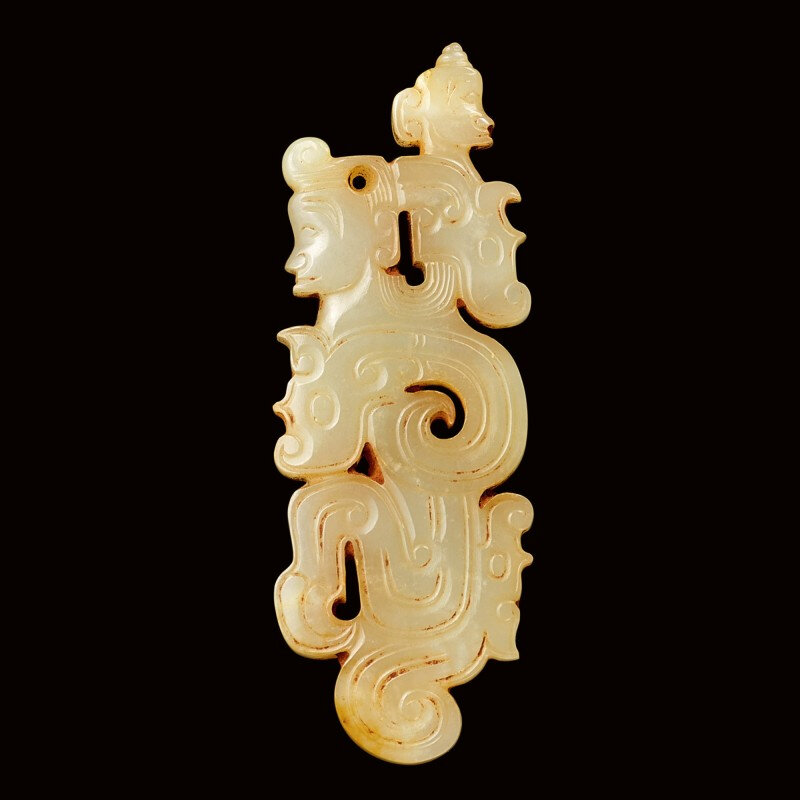Sotheby's. Monochrome II, 9 October 2020, Hong Kong
A very rare jade 'human-dragon' pendant, Western Zhou dynasty (1050-771 BC)
Lot 30. A very rare jade 'human-dragon' pendant, Western Zhou dynasty (1050-771 BC); 7.1 cm, 2 ¾ in. Estimate: 400,000 - 600,000 HKD. Unsold. Courtesy Sotheby's.
skilfully rendered in openwork as three stylised horned dragons and two humanoid heads, the coiling bodies of the beasts exquisitely picked out with scrollwork echoing the outlines of the pendant, pierced through with an aperture.
Property from the Hei-Chi Collection.
Note: The late Shang dynasty period saw a revolutionary change in aesthetic style in ritual bronzes and jades. Among the novelties were jade plaques decorated with humanoid motif, such as a pendant in the form of a crowned human with bent limbs unearthed from the tomb of Fu Hao (c. 1200 BC), included in the exhibition Queen, Mother, General: 40th Anniversary of Excavating the Shang Tomb of Fu Hao, Beijing, 2016, p. 7 (1976AXTM5:470).
The present pendant, reminiscent of the Shang prototypes, ingeniously incorporates two human heads and two dragons on the upper section, atop curled-up human legs terminating in claws and a further dragon with a coiled tail. See a similarly reticulated jade plaque recovered from the tomb of the Marquis of State Jin, Quwo, Shanxi, decorated with a single human and three dragons, published in The Complete Collection of Jades Unearthed in China, vol. 3: Shanxi, Beijing, 2005, pl. 116. Although a variety of human-dragon plaques can be found in public collections across China, few are in private hands and examples made of translucent jade such as the present piece are even rarer. Compare a related huang-shaped ornament from the Dongxi Studio collection, different in form but of comparable quality, sold at Christie’s New York, 17th March 2016, lot 911.
In the Western Zhou dynasty, this type of plaque probably formed parts of ritual necklace sets; see an elaborate set with a related plaque excavated from Qiangjiacun, Fufeng, Shaanxi, exhibited in The Cultural Grandeur of the Western Zhou Dynasty, National Palace Museum, Taipei, 2014, cat. no. 119.

/https%3A%2F%2Fprofilepics.canalblog.com%2Fprofilepics%2F1%2F0%2F100183.jpg)
/https%3A%2F%2Fstorage.canalblog.com%2F03%2F02%2F119589%2F96711876_o.jpg)
/https%3A%2F%2Fstorage.canalblog.com%2F11%2F31%2F119589%2F94773502_o.jpg)
/https%3A%2F%2Fstorage.canalblog.com%2F20%2F83%2F119589%2F94772815_o.jpg)
/https%3A%2F%2Fstorage.canalblog.com%2F26%2F72%2F119589%2F75604929_o.jpg)
/https%3A%2F%2Fstorage.canalblog.com%2F59%2F60%2F119589%2F26458628_o.jpg)



/image%2F1371349%2F20240406%2Fob_de099f_435265592-1644340289669317-27147449708.jpg)
/image%2F1371349%2F20240310%2Fob_c0e13b_431753965-1629270041176342-17091014609.jpg)
/image%2F1371349%2F20240229%2Fob_7c7d11_428701194-1625292201574126-44092414790.jpg)
/image%2F1371349%2F20240229%2Fob_b5ac39_428703110-1625267244909955-59751988979.jpg)